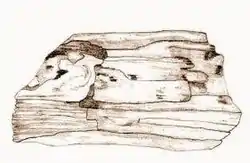Aachenosaurus
Aachenosaurus is a dubious genus of prehistoric plant from the Late Cretaceous (Santonian-Campanian).[1] It was named based solely on fossilized fragments of material that were originally thought to be jaw fragments from a duck-billed dinosaur (a hadrosaur). However, the fossils turned out to be petrified wood, to the great embarrassment of the discoverer. The fossil's name means "Aachen lizard", named for the Aachen Formation of Moresnet (which was a neutral territory between Belgium and Germany), where the fossils were found.[2]
| Aachenosaurus | |
|---|---|
 | |
| Holotype | |
| Scientific classification | |
| Kingdom: | |
| Genus: | †Aachenosaurus Smets, 1888 |
| Binomial name | |
| †Aachenosaurus multidens Smets, 1888 | |
| Synonyms | |
| |
A synonym of Aachenosaurus is Aachenoxylon, which was coined by Dr Maurice Hovelacque in 1889/1890.[3][4][5]
History
The holotype of Aachenosaurus was discovered in 1887 and was named by the scientist (and abbé) Gerard Smets, on October 31, 1888, who named the type species Aachenosaurus multidens. Based on these fragments he determined that the specimen was a hadrosaur reaching an estimated 4 to 5 meters in length which might have had dermal spines.[2] He defended this conclusion, citing that the fossils had been examined visually with the naked eye, magnifying lenses and with the microscope. However, his error was soon demonstrated by Louis Dollo. Smets at first tried to defend his original identification but was again proven wrong by a neutral commission. A rumor abounded that he completely withdrew from science out of pure embarrassment, but not until he had published a paper on turtles in 1889; this rumor was later proven false.[6] The last paper he published was in 1895.
See also
References
- H. N. Andrews. 1970. Index of Generic Names of Fossil Plants, 1820-1965. Geological Survey Bulletin 1-354
- Smets, G. (1888). "Aachenosaurus multidens". Bulletin de la Société belge de géologie, de paléontologie et d'hydrologie. Bruxelles: The society. 12 (2): 300 – via Biodiversity Heritage Library.
- "Aachenoxylon". Retrieved 7 March 2020.
- H., G.F. (1891). "IV.—Sur la nature Végétale de l'Aachenosaurus multidens, G. Smets. Par DrMaurice Hovelacque (Mem. Soc. Belge de Géol. iv. (1890) p. 59 et seq.)". Geological Magazine. Cambridge University Press. 8 (2): 82–83. doi:10.1017/S0016756800185504.
- Stopes, M.C. (1913). Catalogue of the Mesozoic plants in the British museum (Natural history) The Cretaceous flora. p. 39.
- John Wright (2014). The Naming of the Shrew: A Curious History of Latin Names. Bloomsbury Publishing. pp. 47–49. ISBN 978-1-4088-2035-3.